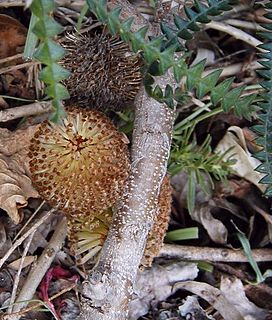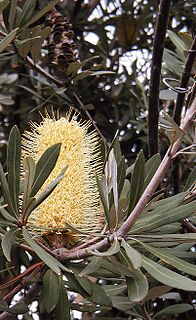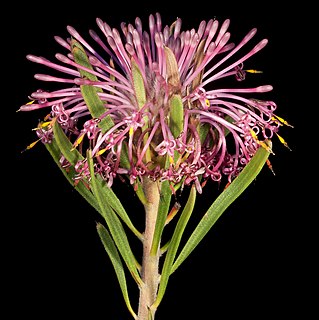
Baeckea is a genus of flowering plants in the myrtle family, Myrtaceae. There are about 75 species, of which 70 are endemic to Australia; the others are distributed in New Caledonia and Southeast Asia.

Banksia dryandroides, the dryandra-leaved banksia, is a species of small shrub in the plant genus Banksia. The Noongar peoples know the tree as manyat. It occurs in shrubland, woodland and kwongan on the south coast of Western Australia between Narrikup and Beaufort Inlet. The species is placed alone in series B. ser. Dryandroideae.

Banksia praemorsa, commonly known as the cut-leaf banksia, is a species of shrub or tree in the plant genus Banksia. It occurs in a few isolated populations on the south coast of Western Australia between Albany and Cape Riche.

Banksia repens, the Creeping Banksia, is a species of shrub in the plant genus Banksia. It occurs on the south coast of Western Australia from D'Entrecasteaux National Park in the west to Mount Ragged in the east.

Banksia victoriae, commonly known as Woolly Orange Banksia, is a species of large shrub or small tree in the plant genus Banksia. It occurs in Western Australia between Northampton, Western Australia and Kalbarri, with the occasional plant further north as far as Zuytdorp Nature Reserve.

Banksia integrifolia subsp. integrifolia is a subspecies of Banksia integrifolia.

Orites is a genus of 9 known species, 7 endemic to Australia and 2 in South America; 1 in the Chilean Andes and 1 in Bolivia.

Chamaescilla is a genus of Australian herbs in the subfamily Hemerocallidoideae within the asphodel family. They have grass-like basal leaves and tuberous roots. The flowers have six petals and six stamens. The seed capsules contain black, glossy seeds.
Banksia gardneri var. gardneri is a variety of Banksia gardneri. As an autonym, it is defined as encompassing the type material of the species. It is native to the Southwest Botanical Province of Western Australia.

Banksia gardneri var. brevidentata is a variety of prostrate shrub that is endemic to the south-west of Western Australia.
Patersonia maxwellii is a perennial herbaceous plant that is endemic to Southwest Australia, occurring in the Jarrah Forest and Esperance Plains regions. The flowers are violet or blue and appear between September and November. The height is 0.2 – 0.3 metres. It is found on white sand in seasonally wet areas. It was first described by Ferdinand von Mueller, placing it in a genus Genosiris, and later transferred to Patersonia by George Bentham. The specific epithet commemorates the collector George Maxwell's contribution to the botany of the region, including this plant's type specimen.

Grevillea parvula , commonly known as Genoa grevillea, is a species of the plant genus Grevillea. It is native to the states of Victoria and New South Wales in Australia.

Codonocarpus is a small genus of shrubs or small trees in the family Gyrostemonaceae.
Hollandaea is a genus of four species known to science, of Australian rainforest trees, constituting part of the plant family Proteaceae.
Nothorites is a genus of a sole described species of trees, constituting part of the plant family Proteaceae. The species Nothorites megacarpus grows naturally only in restricted mountain regions (endemic) of the wet tropics rain forests of north-eastern Queensland, Australia.

Lasjia is a genus of five species of trees of the family Proteaceae. Three species grow naturally in northeastern Queensland, Australia and two species in Sulawesi, Indonesia. Descriptively they are the tropical or northern macadamia trees group. Lasjia species characteristically branched compound inflorescences differentiate them from the Macadamia species, of Australia, which have characteristically unbranched compound inflorescences and only grow naturally about 1,000 km (620 mi) further to the south, in southern and central eastern Queensland and in northeastern New South Wales.

Isopogon linearis is a small shrub in the family Proteaceae that is endemic to the southwest of Western Australia.

Codonocarpus cotinifolius a tall shrub or tree in the Gyrostemonaceae family is a found in all mainland states of Australia, including Victoria, and is widespread in arid areas. It is suspected of being toxic to stock.

Gyrostemon subnudus is a plant in the family, Gyrostemonaceae. It was first described as Amperea subnuda in 1848 by Nees von Esenbeck, and transferred to the genus, Gyrostemon in 1873 by Henri Ernest Baillon.

Gyrostemon racemiger is a plant in the family, Gyrostemonaceae. It was first described in 1909 by Hans Paul Heinrich Walter.
















